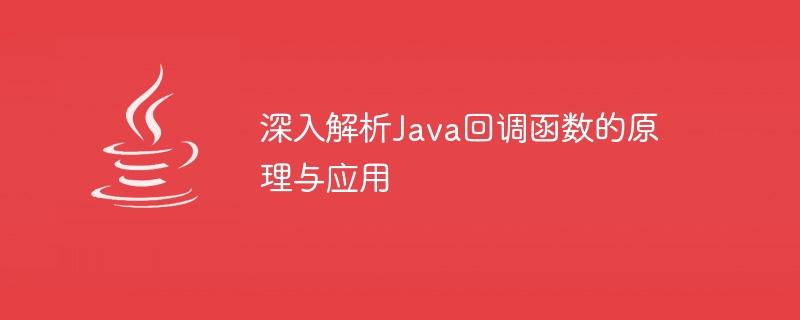
The principle and application of Java callback function
Principle
The callback function is a function passed as a parameter to another function so that when a certain event occurs is called when. A typical use of a callback function is as an event handler, which is called when an event occurs.
In Java, callback functions are usually implemented through interfaces. The interface defines a method signature that is implemented by a callback function. When you need to call the callback function, you only need to call the interface method.
For example, the following code defines an interfaceMyCallback, which defines a methodcallback():
public interface MyCallback { void callback(); }
Copy after login
The following code defines a ClassMyClass, which implements theMyCallbackinterface:
public class MyClass implements MyCallback { @Override public void callback() { System.out.println("Callback method called!"); } }
Copy after login
The following code demonstrates how to use the callback function:
public class Main { public static void main(String[] args) { MyClass myClass = new MyClass(); MyCallback callback = myClass; callback.callback(); } }
Copy after login
When running the above code , will output:
Callback method called!
Copy after login
Application
Callback functions are widely used in Java. The following are some common application scenarios:
- Event processing: callback Functions can act as event handlers, which are called when an event occurs. For example, in Java Swing, button click events can be handled through callback functions.
- Asynchronous programming: Callback functions can be used for asynchronous programming. For example, in Java, you can use callback functions to handle network requests. When the network request is completed, the callback function will be called and can handle the results of the request.
- Thread pool: The callback function can be used in the thread pool. When the thread in the thread pool completes the task, the callback function will be called and can process the results of the task.
- Parallel programming: Callback functions can be used for parallel programming. For example, in Java, you can use callback functions to handle parallel tasks. When the parallel task is completed, the callback function is called and can process the results of the task.
Advantages
The callback function has the following advantages:
- Improving the readability and maintainability of the code: The callback function can make the code more modular and easy maintenance.
- Improve code reusability: Callback functions can improve code reusability. For example, a callback function can be used by multiple different classes.
- Improve the performance of the code: The callback function can improve the performance of the code. For example, in asynchronous programming, callback functions can avoid blocking the main thread.
Disadvantages
The callback function also has some disadvantages:
- Increase the complexity of the code: The callback function may increase the complexity of the code, especially When callback functions are used nested.
- Difficult to debug: Callback functions may make the code difficult to debug, especially when callback functions are used nested.
- May cause memory leaks: Callback functions may cause memory leaks, especially when the callback function holds a reference to the caller.
Notes
When using callback functions, you need to pay attention to the following points:
- The callback function should be as simple as possible and avoid execution within the callback function. Complex logic.
- Callback functions should try to avoid nesting.
- Callback functions should avoid holding references to the caller to avoid memory leaks.
- The callback function should try to avoid throwing exceptions to avoid causing the caller to crash.
Summary
Callback functions are a very useful programming technique that can make code more modular, reusable and efficient. However, when using callback functions, you also need to pay attention to the shortcomings and precautions of callback functions.
The above is the detailed content of Explore the principles and applications of Java callback functions. For more information, please follow other related articles on the PHP Chinese website!


